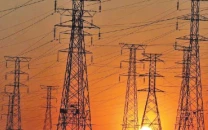Amid low foreign exchange reserves, Punjab gets go-ahead for imported LNG power plant
Ban was specifically placed to reduce import bill, but Cabinet Committee on Energy gives province a waiver

LNG Terminal. PHOTO: REUTERS
The government of Punjab has signed a contract for setting up another Liquefied Natural Gas-fired power plant of 1,263MW, which it said would become operational within 26 months. It will be the fourth LNG-fired power plant being set up in Punjab and the third owned by the provincial government.
The federal government had to give a waiver to Punjab government to set up the imported fuel-based power plant, as the Cabinet Committee on Energy had imposed a ban on setting up new power plants on imported fuels hardly a year ago.
Gwadar LNG pipeline: Finance ministry supports sovereign guarantees
Power Secretary Yousaf Naseem Khokar told The Express Tribune that the federal government did not violate the policy of ban on imported fuel-based power plants, as a waiver had been given by the Cabinet Committee on Energy.
It was a conscious decision to impose the ban on imported fuel based power plants due to its growing implications on foreign exchange reserves. According to Power Division’s estimates, the cost of imported fuel is roughly $500 million per annum to run a 1,300MW power plant.
The decision to impose a ban had been taken to restrict the outflow of foreign currency in the shape of a lower import bill as well as to prevent the repatriation of profits and dividends by project sponsors.
The Punjab government has also managed to save another imported coal-based 1,320MW Rahim Yar Khan power plant’s axing from the China-Pakistan Economic Corridor (CPEC). The federal government had decided to remove the plant from the list of CPEC projects but the Punjab government pressured it to change the decision, said officials.
Finally, the federal government gave in and the revised list of CPEC energy projects signed in May this year on the sidelines of the One-Belt One-Road Summit held in Beijing. The Nishat Group is the sponsor of Rahim Yar Khan power plant, which is still at the very initial stage of its planning.
These two power plants have been added in the list of upcoming power projects at a time when the Power Division itself informed the federal cabinet that the country will have surplus power from next year.
While informing the Cabinet on the supply and demand scenario, the power secretary informed, “From November 2017 till September 2018 there would be surplus supply of electricity and there would be no load-shedding except in high loss areas,” according to documents of September 26, Cabinet meeting.
The secretary also informed that by June 2018 about 11,514MW additional electricity would be added to the system. The additional electricity is significantly more than the 7,938MW shortfall in June 2013 when production was extremely low despite availability of capacity.
But Khokar insisted that he cannot give a firm statement about the availability of the surplus electricity until results of a study undertaken by National Transmission and Dispatch Company (NTDC) are available. Khokar hoped that the results will be known within next four to six weeks.
However, officials said that the NTDC had submitted its provisional findings to a cabinet body, stating that there will be surplus electricity in 2018 and there was no need for adding more power in the national grid. The NTDC officials had also opposed Punjab government projects, said the sources.
Pakistan shelves $2b LNG project
In presence of surplus electricity, the addition of more power has raised questions about the motives of initiating these projects, said the sources. This will put an extra burden on consumers, as under the existing policy the power plant producers are entitled to claim idle capacity payments, if the government does not purchase the electricity despite the availability.
The Managing Director of Private Power Infrastructure Board was not available for comments.
Officials added that these two power plants may add about 50 paisa per unit into the existing electricity tariff being determined by the National Electric Power Regulatory Authority.
But the power ministry officials said that in the absence of any study, the figures for availability of surplus electricity cannot be relied upon. They said that there was also a view that the existing demand was suppressed and once new additions are made, actual demand and supply situation will be clear.
They said that the shortfall had touched 7,000 MW on May 28 this year while ministry’s projection anticipated a peak shortfall of 5,000 MW in May 2017.
Published in The Express Tribune, October 5th, 2017.
Like Business on Facebook, follow @TribuneBiz on Twitter to stay informed and join in the conversation.


















COMMENTS
Comments are moderated and generally will be posted if they are on-topic and not abusive.
For more information, please see our Comments FAQ